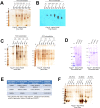Malaria Parasite CLAG3, a Protein Linked to Nutrient Channels, Participates in High Molecular Weight Membrane-Associated Complexes in the Infected Erythrocyte
- PMID: 27299521
- PMCID: PMC4907441
- DOI: 10.1371/journal.pone.0157390
Malaria Parasite CLAG3, a Protein Linked to Nutrient Channels, Participates in High Molecular Weight Membrane-Associated Complexes in the Infected Erythrocyte
Abstract
Malaria infected erythrocytes show increased permeability to a number of solutes important for parasite growth as mediated by the Plasmodial Surface Anion Channel (PSAC). The P. falciparum clag3 genes have recently been identified as key determinants of PSAC, though exactly how they contribute to channel function and whether additional host/parasite proteins are required remain unknown. To begin to answer these questions, I have taken a biochemical approach. Here I have used an epitope-tagged CLAG3 parasite to perform co-immunoprecipitation experiments using membrane fractions of infected erythrocytes. Native PAGE and mass spectrometry studies reveal that CLAG3 participate in at least three different high molecular weight complexes: a ~720kDa complex consisting of CLAG3, RHOPH2 and RHOPH3; a ~620kDa complex consisting of CLAG3 and RHOPH2; and a ~480kDa complex composed solely of CLAG3. Importantly, these complexes can be found throughout the parasite lifecycle but are absent in untransfected controls. Extracellular biotin labeling and protease susceptibility studies localize the 480kDa complex to the erythrocyte membrane. This complex, likely composed of a homo-oligomer of 160kDa CLAG3, may represent a functional subunit, possibly the pore, of PSAC.
Conflict of interest statement
Figures




References
-
- Homewood CA, Neame KD. Malaria and the permeability of the host erythrocyte. Nature. 1974;252: 718–719 - PubMed
-
- Ginsburg H, Kutner S, Zangwil M, Cabantchik ZI. Selectivity properties of pores induced in host erythrocyte membrane by Plasmodium falciparum. Effect of parasite maturation. Biochim Biophys Acta. 1986;861:194–196. - PubMed
-
- Staines HM, Rae C, Kirk K. Increased permeability of the malaria-infected erythrocyte to organic cations. Biochim. Biophys. Acta. 2000;1463:88–98 - PubMed
-
- Ginsburg H, Kutner S, Krugliak M, Cabantchik ZI. Characterization of permeation pathways appearing in the host membrane of Plasmodium falciparum infected red blood cells. Mol. Biochem. Parasitol. 1985;14:313–322 - PubMed
-
- Desai SA, Bezrukov SM, Zimmerberg J. A voltage-dependent channel involved in nutrient uptake by red blood cells infected with the malaria parasite. Nature. 2000;406:1001–1005 - PubMed
MeSH terms
Substances
LinkOut - more resources
Full Text Sources
Other Literature Sources

